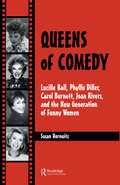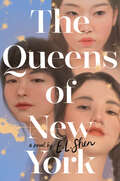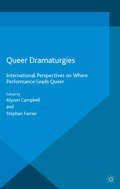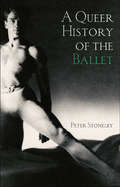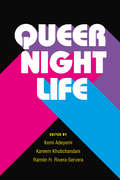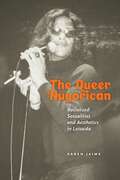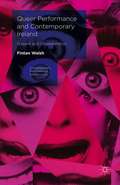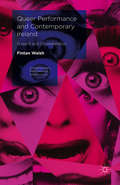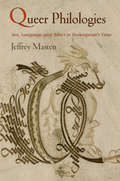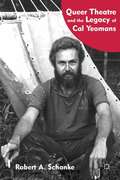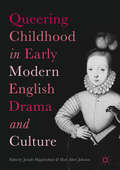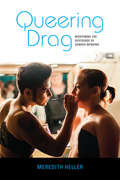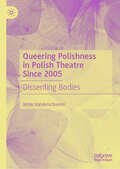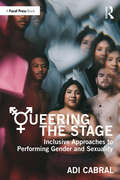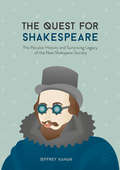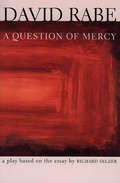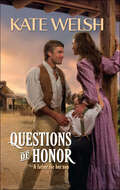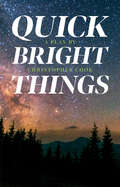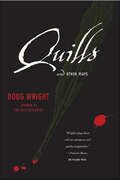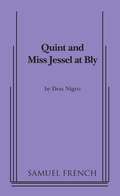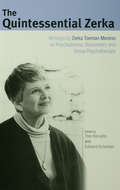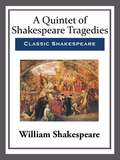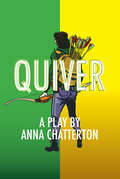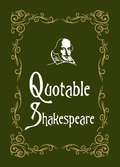- Table View
- List View
Queens of Comedy: Lucille Ball, Phyllis Diller, Carol Burnett, Joan Rivers, and the New Generation of Funny Women
by Susan HorowitzThrough candid personal interviews with Lucille Ball, Carol Burnett, and other visionary performers, Queens of Comedy explores how comediennes have redefined the roles of women in not only the entertainment business, but society as a whole. Detailing both their public and private lives - as well as their many and varied performances - Queen of Comedy examines the impact these women have had on the predominantly male-oriented world of comedy. Performers like Carol Burnett, Joan Rivers, and their more recent counterparts, comediennes Brett Butler and Roseanne, have helped to sift women's roles in comedy from object to subject. This book maps out this shift, providing an often brutally honest picture of women's lives in both the spotlight of comedy and this modern world.
The Queens of New York: A Novel
by E. L. ShenFrom acclaimed author E. L. Shen comes a sun-drenched, cinematic YA novel about three Asian American girls, their unbreakable bond, and one life-changing summer, perfect for fans of The Sisterhood of the Traveling Pants.Best friends Jia Lee, Ariel Kim, and Everett Hoang are inseparable. But this summer, they won’t be together.Everett, aspiring Broadway star, hopes to nab the lead role in an Ohio theater production, but soon realizes that talent and drive can only get her so far. Brainy Ariel is flying to San Francisco for a prestigious STEM scholarship, even though her heart is in South Korea, where her sister died last year. And stable, solid Jia will be home in Flushing, juggling her parents’ Chinatown restaurant, a cute new neighbor, and dreams for an uncertain future.As the girls navigate heartbreaking surprises and shocking self-discoveries, they find that even though they’re physically apart, they are still mighty together.
Queer Dramaturgies: International Perspectives on Where Performance Leads Queer (Contemporary Performance InterActions)
by Alyson Campbell Stephen FarrierThis international collection of essays forms a vibrant picture of the scope and diversity of contemporary queer performance. Ranging across cabaret, performance art, the performativity of film, drag and script-based theatre it unravels the dynamic relationship performance has with queerness as it is presented in local and transnational contexts.
A Queer History of the Ballet
by Peter StoneleyDesigned for students, scholars and general readers with an interest in dance and queer history, A Queer History of the Ballet focuses on how, as makers and as audiences, queer men and women have helped to develop many of the texts, images, and legends of ballet. Presenting a series of historical case studies, the book explores the ways in which, from the nineteenth century into the twentieth, ballet has been a means of conjuring homosexuality – of enabling some degree of expression and visibility for people who were otherwise declared illegal and obscene. Studies include: the perverse sororities of the Romantic ballet the fairy in folklore, literature, and ballet Tchaikovsky and the making of Swan Lake Diaghilev’s Ballets Russes and the emergence of queer modernity the formation of ballet in America the queer uses of the prima ballerina Genet’s writings for and about ballet. Also including a consideration of how ballet’s queer tradition has been memorialized by such contemporary dance-makers as Neumeier, Bausch, Bourne, and Preljocaj, this is an essential book in the study of ballet and queer history.
Queer Nightlife (Triangulations: Lesbian/Gay/Queer Theater/Drama/Performance)
by Ramon Rivera-Servera Kareem Khubchandani Kemi AdeyemiThe mass shooting at a queer Latin Night in Orlando in July 2016 sparked a public conversation about access to pleasure and selfhood within conditions of colonization, violence, and negation. Queer Nightlife joins this conversation by centering queer and trans people of color who apprehend the risky medium of the night to explore, know, and stage their bodies, genders, and sexualities in the face of systemic and social negation. The book focuses on house parties, nightclubs, and bars that offer improvisatory conditions and possibilities for “stranger intimacies,” and that privilege music, dance, and sexual/gender expressions. Queer Nightlife extends the breadth of research on “everynight life” through twenty-five essays and interviews by leading scholars and artists. The book’s four sections move temporally from preparing for the night (how do DJs source their sounds, what does it take to travel there, who promotes nightlife, what do people wear?); to the socialities of nightclubs (how are social dance practices introduced and taught, how is the price for sex negotiated, what styles do people adopt to feel and present as desirable?); to the staging and spectacle of the night (how do drag artists confound and celebrate gender, how are spaces designed to create the sensation of spectacularity, whose bodies become a spectacle already?); and finally, how the night continues beyond the club and after sunrise (what kinds of intimacies and gestures remain, how do we go back to the club after Orlando?).
The Queer Nuyorican: Racialized Sexualities and Aesthetics in Loisaida (Performance and American Cultures #4)
by Karen JaimeFinalist for The Barnard Hewitt Award for Outstanding Research in Theatre History, given by the American Society for Theatre Research.Silver Medal Winner of The Victor Villaseñor Best Latino Focused Non-Fiction Book Award, given by the International Latino Book Awards.Honorable Mention for the Best LGBTQ+ Themed Book, given by the International Latino Book Awards.A queer genealogy of the famous performance space and the nuyorican aesthetic One could easily overlook the Nuyorican Poets Cafe, a small, unassuming performance venue on New York City’s Lower East Side. Yet the space once hosted the likes of Victor Hernández Cruz, Allen Ginsberg, and Amiri Baraka and is widely credited as the homespace for the emergent nuyorican literary and aesthetic movement of the 1990s. Founded by a group of counterculturalist Puerto Rican immigrants and artists in the 1970s, the space slowly transformed the Puerto Rican ethnic and cultural associations of the epithet “Nuyorican,” as the Cafe developed into a central hub for an artistic movement encompassing queer, trans, and diasporic performance. The Queer Nuyorican is the first queer genealogy and critical study of the historical, political, and cultural conditions under which the term “Nuyorican” shifted from a raced/ethnic identity marker to “nuyorican,” an aesthetic practice. The nuyorican aesthetic recognizes and includes queer poets and performers of color whose writing and performance build upon the politics inherent in the Cafe’s founding. Initially situated within the Cafe’s physical space and countercultural discursive history, the nuyorican aesthetic extends beyond these gendered and ethnic boundaries, broadening the ethnic marker Nuyorican to include queer, trans, and diasporic performance modalities. Hip-hop studies, alongside critical race, queer, literary, and performance theories, are used to document the interventions made by queer and trans artists of color—Miguel Piñero, Regie Cabico, Glam Slam participants, and Ellison Glenn/Black Cracker—whose works demonstrate how the Nuyorican Poets Cafe has operated as a queer space since its founding. In focusing on artists who began their careers as spoken word artists and slam poets at the Cafe, The Queer Nuyorican examines queer modes of circulation that are tethered to the increasing visibility, commodification, and normalization of spoken word, slam poetry, and hip-hop theater in the United States and abroad.
Queer Performance and Contemporary Ireland: Dissent and Disorientation (Contemporary Performance InterActions)
by Fintan WalshThis book examines the surge of queer performance produced across Ireland since the first stirrings of the Celtic Tiger in the mid-1990s, up to the passing of the Marriage Equality referendum in the Republic in 2015.
Queer Performance and Contemporary Ireland: Dissent and Disorientation (Contemporary Performance InterActions)
by Fintan WalshThis book examines the surge of queer performance produced across Ireland since the first stirrings of the Celtic Tiger in the mid-1990s, up to the passing of the Marriage Equality referendum in the Republic in 2015.
Queer Philologies: Sex, Language, and Affect in Shakespeare's Time
by Jeffrey MastenFor Jeffrey Masten, the history of sexuality and the history of language are intimately related. In Queer Philologies, he studies particular terms that illuminate the history of sexuality in Shakespeare's time and analyzes the methods we have used to study sex and gender in literary and cultural history. Building on the work of theorists and historians who have, following Foucault, investigated the importance of words like "homosexual," "sodomy," and "tribade" in a variety of cultures and historical periods, Masten argues that just as the history of sexuality requires the history of language, so too does philology, "the love of the word," require the analytical lens provided by the study of sexuality.Masten unpacks the etymology, circulation, transformation, and constitutive power of key words within the early modern discourse of sex and gender--terms such as "conversation" and "intercourse," "fundament" and "foundation," "friend" and "boy"--that described bodies, pleasures, emotions, sexual acts, even (to the extent possible in this period) sexual identities. Analyzing the continuities as well as differences between Shakespeare's language and our own, he offers up a queer lexicon in which the letter "Q" is perhaps the queerest character of all.
Queer Theatre And The Legacy Of Cal Yeomans
by Robert A. SchankeA forgotten yet award-winning playwright, Cal Yeomans was one of the founders of gay theater whose work was fueled by gay liberation and extinguished by the AIDS epidemic. Schanke's examination of his life and legacy allows a rare exploration into this pivotal moment of gay American history.
Queering Childhood in Early Modern English Drama and Culture
by Jennifer Higginbotham Mark Albert JohnstonThis volume analyzes early modern cultural representations of children and childhood through the literature and drama of Shakespeare and his contemporaries. Contributors include leading international scholars of the English Renaissance whose essays consider asexuals and sodomites, roaring girls and schoolboys, precocious princes and raucous tomboys, boy actors and female apprentices, while discussing a broad array of topics, from animal studies to performance theory, from queer time to queer fat, from teaching strategies to casting choices, and from metamorphic sex changes to rape and cannibalism. The collection interrogates the cultural and historical contingencies of childhood in an effort to expose, theorize, historicize, and explicate the spectacular queerness of early modern dramatic depictions of children.
Queering Drag: Redefining the Discourse of Gender-Bending
by Meredith HellerTheatrical gender-bending, also called drag, is a popular form of entertainment and a subject of scholarly study. However, most drag studies do not question the standard words and ideas used to convey this performance genre. Drawing on a rich body of archival and ethnographic research, Meredith Heller illuminates diverse examples of theatrical gender-bending: male impersonation in variety and vaudeville (1860–1920); the "sexless" gender-bending of El Teatro Campesino (1960–1980); queer butch acts performed by black nightclub singers, such as Stormé DeLarverie, instigator of the Stonewall riots (1910–1970); and the range of acts that compose contemporary drag king shows. Heller highlights how, in each case, standard drag discourses do not sufficiently capture the complexity of performers' intents and methods, nor do they provide a strong enough foundation for holistically evaluating the impact of this work. Queering Drag offers redefinition of the genre centralized in the performer's construction and presentation of a "queer" version of hegemonic identity, and it models a new set of tools for analyzing drag as a process of intents and methods enacted to effect specific goals. This new drag discourse not only allows for more complete and accurate descriptions of drag acts, but it also facilitates more ethical discussions about the bodies, identities, and products of drag performers.
Queering Polishness in Polish Theatre Since 2005: Dissenting Bodies
by Jonas VanderschuerenTheatre has long been an art form at the centre of public life in Poland. Whether it is the self-professed poet-prophets of the Romantic era, or the dissident theatre makers working under the strictures of state socialism, the art form has played a vital role in the development of Polish culture and politics in the context of shifting foreign occupations. This book explores the relationship between contemporary Polish theatre makers and contemporary notions of Polishness and argues that queer theory, and specifically a Polish appropriation of queer theory, can be a crucial element to better understand the politicality of the contemporary Polish theatre field. It does this by focusing on critical theatre productions which are produced at the margins of the Polish theatre field, a choice which has been made as the field is dominated by traditional drama theatres which reproduce a Polish variation on the Western canon. This makes smaller, atypical, and independent theatre productions all the more significant, as they signify a refusal to continue the traditional role of the Polish theatre field in reproducing the canon of Polish Romanticism. As such, the book argues that contemporary Polish theatre has been marked by a struggle between those building performances and state authorities that see those creations as a threat to their authority.
Queering the Stage: Inclusive Approaches to Performing Gender and Sexuality
by Adi CabralQueering the Stage: Inclusive Approaches to Performing Gender and Sexuality addresses a history of stereotyping and provides inclusive approaches to navigating gender and sexuality in a way that does not reduce the broad spectrum of LGBTQ+ communities into a single monolith.Butch it up! Be more manly! Add a little swish! Queen out! These instructions make performers feel minimized, erased, and forced to fit in a binary that encourages underdeveloped portrayals of queer identities. This book will guide the reader in performance techniques for confidently embodying the masculine/ feminine, gay/ straight binaries – as concepts of chosen choreography rather than reductive prescriptions – while also providing non- binary exercises to explore and expand the use of the body, voice, heart, and mind to bring life to characters of sexual orientations and gender identities that do and do not align with the actors’ lived experiences. The reader will be presented with multiple tools for analyzing, developing, and embodying a diverse array of characters, empowering them to make their own choices when it comes to performance. While there is no “right” way to teach performance, this book will present tools rooted in trauma- informed practices that aim to prevent and undo harm in a group setting with a facilitator, or individually.This book is written for instructors of theatre performance and acting wishing to expand their curriculum to include queer concepts in their classroom, and actors working in the industry who want to improve their ability performing characters of diverse genders and sexualities.A companion website, available at www.adicabral.com/queering-the-stage, provides additional materials to support exercises given throughout the book.
Queering W. B. Yeats and Gabriele D’Annunzio: Modernist Playwrights (New Directions in Irish and Irish American Literature)
by Zsuzsanna BalázsQueering W. B. Yeats and Gabriele D’Annunzio: Modernist Playwrights challenges the general resistance in scholarship and queer studies to approach Yeats and D’Annunzio through a queer lens because of their controversial affiliations with fascism and elitism, their heterosexuality and their venerated canonical status. This book provides the first fully theorised queer and comparative reading of Yeats’s and D’Annunzio’s drama. It offers the novel contention that due to their increasing involvement in queer and feminist subcultures, their plays feature feelings that are associated with queer historiography and generate ideas that began to be theorised by queer studies more than half a century after the composition of the plays. Moreover, it uncovers an alert, subversive and often coded social commentary in eight key dramatic texts by each playwright and at the same time highlights the thus far neglected commonalities between the plays and the queer historical as well as cultural contexts of these two prominent modernists.
The Quest for Shakespeare
by Jeffrey KahanThis book traces the formation and impact of the New Shakspeare Society, created in 1873, which dedicated itself to solving the mysteries of Shakespeare's authorship by way of science. This promise, however, was undermined not only by the antics of its director, Frederick J. Furnivall, but also by the inexactitudes of the tests. Jeffrey Kahan puzzles out how a society geared towards science quickly devolved into a series of grudge matches. Nonetheless, the New Shakspere Society set the bibliographical and biographical agenda for the next century--an unusual legacy for an organization that was rife with intrigue, enmity, and incompetence; lives were ruined, lawyers consulted, and scholarship (mostly bad) produced and published.
A Question of Mercy: A Play Based on the Essay by Richard Selzer (Books That Changed the World)
by David RabeThe Tony Award–winning playwright of Hurlyburly &“confronts the timely topic of assisted suicide . . . an affirmation of dignity that rings clear and true&” (Variety). David Rabe is one of America&’s finest dramatists. In A Question of Mercy, he explores the controversial and emotional issue of euthanasia, delving deep into the ties that bind friends and lovers. Thomas and Anthony are lovers struggling with Anthony&’s final, exhausting battle with AIDS. Joined by their friend Susanah and a retired doctor, whose help Thomas has requested, they fashion a heartbreaking friendship as they work through the stages of a plan to relieve Anthony of his illness and his life. Rabe creates a passionate depiction of four people confronted with the reality of a loved one&’s fight with death and a compelling dramatic event that poses the question: &“What would you do?&” &“A moving and enlightening experience.&” —Backstage &“Completely gripping. This life and death tale questions the moral implications involved with assisted suicide, and the honor behind the action. A serious and provocative night at the theatre.&” —Theasy Praise for David Rabe &“Few contemporary dramatists have dealt with violence, physical and psychological, more impressively than Rabe.&” —Kirkus Reviews &“A remarkable storyteller.&” —Chicago Tribune &“Rabe&’s mastery of dialogue is the equal of Pinter and Mamet put together . . . full of a measured Mafia formality played against Jacobean terrors, blood lust, horror and revenge raised to an unlikely poetry dazed by equally unlikely insights.&” —The Boston Globe
Questions of Honor
by Kate WelshA stern, rock-hard man stood before Abaigeal Sullivan. No sign of the boy whose playful teases had once turned to stolen kisses and something much, much more. Why, in all the years Joshua Wheaton had been away, had he never made contact, acknowledged her astounding news-that she carried his child? Abby no longer trusted any man, but could she believe Joshua when he claimed he only ever meant to act honorably toward her? There was no doubt he wanted to get closer to her and the son that they had created together.
Quick Bright Things
by Christopher Cook“Everyone hears voices. I’m treated like I’m broken for admitting it.” Can a weekend trip to visit family ever be smooth? Nick was hoping for a quick dinner at his brother Reid’s house when he stopped by with his seventeen-year-old adopted son, Gerome, on their way to meet Gerome’s birth mother. Gerome was recently diagnosed with schizophrenia, and he wants to know more about his family history. Though Reid and his family wreak havoc with their well-meaning but misguided ideas about Gerome’s diagnosis, they manage to convince Nick and his son to stay the night, even after they find Gerome on the roof ready to demonstrate backflips. The dinner pit stop becomes a tense weekend-long event full of claims and questions as the family attempts to “un-crazy” Gerome, leading them all to a dangerous breaking point. With truth, humour, and pathos, Quick Bright Things explores a family’s struggle with understanding mental health, their ways of expressing love, and what it ultimately means to be “okay.”
Quills and Other Plays
by Doug WrightSelected early works from the Pulitzer Prize-winning playwright.Throughout his work, Doug Wright has often combined the personal, the social, and the political, in the process unearthing fundamental truths about life and art while casting an unblinking eye on the dark--and darkly funny--side of human nature. Gathered here are three of Wright's early plays, including Interrogating the Nude, a tongue-in-cheek reimagining of the uproar surrounding the debut of Marcel Duchamp's work in America; Watbanaland, a satiric dissection of yuppie desire and a haunting look at family and faith; and the Obie Award-winning Quills, which explores the boundaries of artistic expression and the dangers of censorship as they played out in the Marquis de Sade's final days at Charenton Asylum.
Quint and Miss Jessel at Bly
by Don NigroDramaCharacters: 2 male, 1 female. Unit Set. Peter Quint is sent by his lifelong employer, the Master of Bly, to be the servant in charge of a remote English country house where Miss Jessel has just arrived to be governess to the orphaned children of the master's brother. The ultimately deadly love triangle that results forms a darkly funny and erotic Gothic love story. These are the lovers who haunt Henry James's The Turn of the Screw. Quint is brilliant, sardonic and angry, a man of great abilities trapped by birth into a subservient role he hates. Miss Jessel is beautiful, headstrong, troubled, and deeply infatuated with the master. As Quint and Miss Jessel's affair develops, the rivalry between servant and master builds to a frightening and haunting climax.
The Quintessential Zerka: Writings by Zerka Toeman Moreno on Psychodrama, Sociometry and Group Psychotherapy
by Zerka T MorenoThe Quintessential Zerka documents the origins and development of the theory and practice of psychodrama, sociometry and group psychotherapy through the work and innovation of its co-creator, Zerka Toeman Moreno. This comprehensive handbook brings together history, philosophy, methodology and application. It shows the pioneering role that Zerka, along with her husband J. L. Moreno, played in the development, not only of the methods of psychodrama and sociometry, but of the entire group psychotherapy movement worldwide. It demonstrates the extent to which Zerka's intuitive and intellectual grasp of the work, combined with her superb ability to organize and synthesize, continue to exert an influence on the field. Toni Horvatin and Edward Schreiber have selected articles that span a career of some sixty years, from Zerka’s very first publication to recent, previously unpublished, work. Personal anecdotes and poetry from Zerka herself provide a valuable context for each individual article. The selection includes: psychodrama, it's relation to stage, radio and motion pictures psychodramatic rules, techniques and adjunctive methods beyond aristotle, breuer and freud: Moreno’s contribution to the concept of catharsis psychodrama, role theory and the concept of the social atom. This book provides a rich source of insight and inspiration for all those interested in the history, development and practice of psychodrama, sociometry and group psychotherapy, whatever their level of experience. It will be of interest to anyone involved in the fields of psychology, counselling, sociology, social work, education, theatre, or human relations.
A Quintet of Shakespeare Tragedies
by William ShakespeareMurder, Mayhem, and Madness-- Collected here are five of William Shakespeare's greatest tragedies Romeo and Juliet, Hamlet, Macbeth, Othello, and King Lear. These are the plays that made Shakespeare's reputation. Murder, deceit, treachery, and madness play out on the grand stage. Stories for the ages! Tomorrow, and tomorrow, and tomorrow Creeps in this petty pace from day to day To the last syllable of recorded time; And all our yesterdays have lighted fools The way to dusty death. Out, out, brief candle! Life's but a walking shadow, a poor player That struts and frets his hour upon the stage And then is heard no more. It is a tale Told by an idiot, full of sound and fury, Signifying nothing.
Quiver
by Anna Chatterton“She doesn’t care about me; she doesn’t even want to see me; she just pretends she does.” Shy, fourteen-year-old Maddie wasn’t expecting to have to worry about taking care of herself just yet. Her sixteen-year-old party-girl sister Bea has scandalously moved in with their mom’s ex-boyfriend, and in turn their brassy mother Sheila has run straight to the comfort of another lover. Maddie is finding that an empty apartment is quiet and lonely, even though her time is normally spent reading comics in her closet. Feeling abandoned and vulnerable, she turns to her favourite superhero, Arrowette. Armed with a backpack filled with a bow and arrows, she embarks on a radical plan to join the army, where she thinks she will find a new family she can count on. Meanwhile, Bea is second-guessing the whole dating an older man thing, and Sheila defends her unorthodox sexual candour, entertaining the ideals of freedom. When Bea and Sheila decide to come home for Maddie’s birthday, they’re faced with the pointed arrow of Maddie’s newfound power and the startling reality of the kind of family they’ve become.
Quotable Shakespeare (Quotable Ser.)
by Max MorrisThis entertaining collection gathers together William Shakespeare's wisest and wittiest quotations. Quotable Shakespeare proves that brevity is the soul of wit and is sure to delight all lovers of the Bard's uniquely perceptive and influential works.
